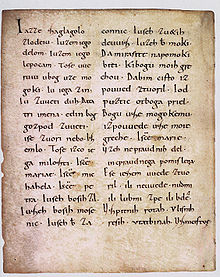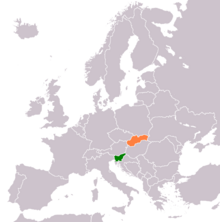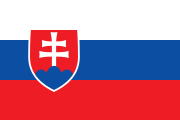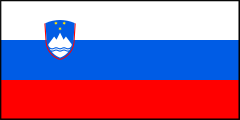German-Slovenian relations

|
|
|
|
|
| Germany | Slovenia |
The German-Slovenian relations are now marked by the partnership of Slovenia within the European Union with Germany as the largest economy of the Community. Within the EU, both countries have introduced the euro as their currency and are part of the Schengen area . Outside the EU, they are members of the Council of Europe , the Organization for Security and Cooperation in Europe, and NATO . The German Foreign Office assesses the relationship as "very good and characterized by mutual trust".
history
The relationship between Germany and Slovenia can historically be traced back to the predecessor states, namely Carantania on the one hand and the Franconian Empire and then the Eastern Franconian Empire and especially the Bavarian tribal duchy .
From the second half of the 6th century, the Baiwar Agilolfingers were the opponents of the Slavic- Avar "community of nations" that immigrated to what is now Slovenia after the fall of the Roman Empire . In 592 there was the first major clash with Tassilo I , Duke of the Bavarians , to whom the Alpine Slavs were subject. In 595, however, the Bavarian Agilolfinger lost almost their entire tribal army , 2000 warriors, when the Slavs were supported by the cavalry of the Avar Chagan . Both disputes can be located in what is now the Austrian Upper Drautal .
After the weakening of the Avars in 626 due to conflicts with the Byzantine Empire, the Slavic Samo Empire emerged in the power vacuum between the Bavarians and the Avars , to which, according to Czech and Slovak historians, the areas of present-day Carinthia and present-day Republic of Slovenia did not belong , although Samo was able to extend his influence to the Alpine Slavs. For other historians, however, Carinthia and Slovenia were very much part of the Samo Empire. With Samos death 658 the reports end up over his kingdom, but even after death Samos remained the Alpine Slavs under their Wallucus (= ruler ) free from the dominion over the Avars.
Around or after 610 the Alpine Slavs again prevailed against the Bavarians, this time against the Agilolfinger Duke Garibald II in Aguntum in what is now East Tyrol . With these armed conflicts, the Alpine Slavic sphere of influence expanded to the Upper Styrian Enns , in the Salzburg Enns-Pongau , the Pongau side valleys of the Salzach into the Gastein Valley , and to Innichen in the Puster Valley in what is now South Tyrol. This proto-Slovene principality with its center in Karnburg (Slov. Krnski grad) on the Zollfeld north of Klagenfurt was called Karantanien .
economy

Economic cooperation between the two states can develop freely within the European Customs Union and the European internal market (free movement of goods, services, capital and people) of the European Union. The common currency " Euro ", which Slovakia joined in 2007, also eliminates intra-Community exchange rate risks and the resulting currency hedging for German and Slovenian companies.
19.3% of all Slovenian exports went to Germany in 2016. Germany was also in first place for imports to Slovenia with 16.8%. This makes Germany Slovenia's most important trading partner ahead of Italy and Austria.
According to the Federal Foreign Office, around "570 German companies and companies with German participation" are active in Slovenia.
Transport, travel and tourism
Street
Since both states belong to the Schengen area , there are normally no more border controls between each other. However, since the refugee crisis in Europe from 2015 , there have been more controls at the German-Austrian border and thus on the way from Slovenia to Bavaria.
A fast connection on the road between southern Germany and Slovenia is the Austrian Tauern motorway and then the Karawanken motorway to the Slovenian border.
rail
The central station of Ljubljana can be reached from Munich with a continuous Euro City in 6:15 hours.
air traffic
There are direct connections to and from Ljubljana Airport with Adria Airways , the national Slovenian airline, and Lufthansa to and from Frankfurt and Munich , as well as to Hamburg with Adria Airways . With VLM / Hahn Air you can get from Munich to Maribor without having to change trains . The flight time is approximately 50 minutes to approximately two hours, depending on the distance.
On March 16, 2015, the German Fraport AG took over 100% of Ljubljana Airport.
On the water
The Slovenian rivers are essentially not navigable.
Slovenia has access to the Mediterranean and the Atlantic Ocean through the port of Koper on the Adriatic Sea . Thus the country is z. B. connected with the port of Hamburg - if only in the course of a bypass of Western Europe.
By bicycle
Germany is connected to Slovenia by the Iron Curtain Route ( EuroVelo route EV13).
On foot
The Violet Path of the Via Alpina connects Germany via Austria with Slovenia.
tourism
With 307,410 arrivals in 2016, German visitors made up the third largest international guest group in Slovenian tourism after Italians and Austrians. The most popular travel month was August. 38% of German tourists stayed in the mountains, 22% by the sea, 15% in health tourism accommodation , 11% in the capital Ljubljana, 8% in other cities and 6% in other municipalities.
Culture, science and media
Cultural and scientific contacts
The Freising Monuments , which were written in the second half of the 10th century and the first half of the 11th century , are the oldest evidence of the Slovene language. The name of the documents refers to the origin of the documents and points to the very old ones cultural or religious relationship between the Bavarian and the Slovenian area: they were used in the context of the missionary work of the Diocese of Freising in its possessions in Carinthia. Today the "monuments" are among the treasures of the Bavarian State Library . For today's Slovenia they are of paramount importance.
The German-Slovenian cultural relations are historically shaped by the geographical proximity, by the long rule of the Habsburgs over Slovenian areas and the associated great importance of the German language as a language of culture and science over many centuries.
Nowadays the Goethe-Institut in Ljubljana serves the cultural exchange and the promotion of German culture in Slovenia.
As the Foreign Office writes, "at schools [...] German is the second strongest language after English. In Slovenia there are around 70,000 learners of German. The German language diploma can be obtained at a total of 22 schools."
At the Ludwig Maximilians University in Munich , the Slovenian language can be learned in language courses as part of Slavic philology . Language courses are also held at the Humboldt University in Berlin .
German studies can be studied at the University of Ljubljana and the University of Maribor .
media
A "Laibacher Zeitung" has been published by the German minority in Slovenia since 2017, following on from a press of the same name in the Habsburg monarchy until 1918.
Work and life
As part of the EU free movement of workers , Germans in Slovenia and Slovenes in Germany can work without any problems.
Germany was among the EU-15 countries, which their labor markets in the wake of EU enlargement in 2004 , while Slovenia also joined the Community, with most abschotteten . The topic had been discussed controversially in advance, and the fear was expressed that the German labor market would not be able to cope with a "rush" and that there could be increased unemployment among the local population. According to this, Germany restricted access to its labor market under the 2-3-2 formula and, together with Austria, was one of the two countries for which full freedom of movement did not apply until May 1, 2011. The restrictions on the free movement of workers were reciprocal in the case of Slovenia, meaning that Slovenia in turn restricted access to its labor market for members of the "old" EU-15.
Sports
Soccer
So far, the Slovenian national soccer team has only played one game against the German national soccer team . The friendly match in Celje on March 26, 2005 was lost for Slovenia after a goal by Lukas Podolski with 0: 1.
In qualifying for the 2006 World Cup in Germany , Slovenia failed to Italy and Norway and was therefore not represented at the tournament.
Handball
At the 2004 European Handball Championship in Slovenia, the German national handball team won the title for the first time by beating the hosts in the final .
Skiing
Slovenia is a shination. So far, the two Slovenes Primož Peterka and Peter Prevc have won the Four Hills Tournament in Germany and Austria .
On the Letalnica bratov Gorišek ski jump in Planica , Slovenia , the Germans Ralph Gebstedt , Martin Schmitt , Sven Hannawald , Hansjörg Jäkle and Michael Uhrmann have won first place in international competitions .
Mutual perception: likelihood of confusion with Slovakia
Some Germans have difficulties telling Slovakia and Slovenia apart, which can lead to displeasure among the Slovenes. In fact, both country names come from the original name of all Slavs, the Sloveni . The fact that the Slovak name for their country is "Slovensko" does not add to the relief of the situation.
Both states rely on a Slavic identity, with the Slovaks being counted among the Western Slavs and the Slovenes among the Southern Slavs . Up to the First World War , both Slovakia and Slovenia were part of Austria-Hungary , with Slovakia belonging to the Kingdom of Hungary and Slovenia to the Austrian-dominated Cisleithanien . Both countries were also part of a larger state for much of the 20th century: Slovakia was integrated into Czechoslovakia , Slovenia into Yugoslavia . Slovenia fought for its independence in short battles against the Yugoslav People's Army (JNA) in the 10-day war (declaration of independence on June 25, 1991). Slovakia achieved its independence peacefully on January 1, 1993.
The flag of Slovakia uses the Pan-Slavic colors white-blue-red.
The flag of Slovenia also uses these colors and is therefore easy to confuse.
The coat of arms of Slovakia differs from its Slovenian counterpart in the patriarchal cross . The Dreiberg symbolizes the three mountains of the northern Kingdom of Hungary, namely the Tatra , Fatra and Mátra .
In the coat of arms of Slovenia, however , the three mountain peaks stand for the Triglav in the Julian Alps .
Germans in Slovenia, Slovenes in Germany

A German minority in Slovenia is disappearing: the Gottscheers
The traditional German-speaking minority of the Gottscheers has all but disappeared in Slovenia today.
An unknown number of Gottscheer descendants live in Slovenia today. Of these, however, only very few refer to themselves as “Germans” or “Gottscheers” in censuses. In a survey conducted as part of a dissertation in 2007, out of 16 Gottscheers surveyed in Slovenia, eleven described themselves as “Slovenes” with regard to their “nationality”, three as “Gottscheers” and only one person as “German”. Due to the strong social and political pressure in Yugoslavia, the Gottscheers have largely absorbed into the Slovenian population today. The Gottscheer dialect is only spoken by a few, mostly old people, and they too use Slovenian on most occasions.
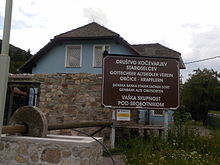
To this day, the commitment to Gottscheer origin and culture in the region is sometimes associated with discrimination, and isolated private bilingual boards are the target of vandalism.
Gottscheer associations in Slovenia
Today in Slovenia there are five organizations of Gottscheers or Gottscheer Germans and their descendants. The in Ljubljana (1994 Ljubljana founded) Association Peter Kosler , now based in Gottschee / Kočevje has to get the goal that Slovenian, German and Gottscheer literary heritage of the Gottschee region. The Gottscheer Altsiedlerverein , founded in 1992 in Pöllandl ( Kočevske Poljane , Dolenjske Toplice municipality ), on the other hand, sees itself as an organization of the German minority and operates a meeting place in the village of Krapflern ( Občice , Dolenjske Toplice municipality), where it is also based. There are now three other Gottscheer cultural associations in Slovenia: the facility for the preservation of the Moschnitze cultural heritage (Zavod za ohranitev kulturne dediščine) with the Schauer Hall in Pöllandl, the cultural-tourist association under the Gutenberg (Turistično društvo pod Srebotnikom) with the chairman Urška Kop from Krapflern and the facility for the preservation of the cultural heritage Nesseltal (Zavod za ohranitev kulturne dediščine Nesseltal Koprivnik) with a museum and an apartment for 5 people.
No recognition as an ethnic minority
Slovenia does not grant the Gottscheers and, in contrast to Croatia, also the ethnic Germans as a whole, no minority protection according to the Copenhagen CSCE Conference of 1990 , so that the Gottscheers receive no special financial or other support. There are no German-language or bilingual lessons which, due to school legislation, are only intended for the recognized “autochthonous” minorities (Italians and Hungarians).
In 2007 the Committee of Ministers of the Council of Europe recommended that the Slovenian authorities “work with the speakers to determine the areas in which German and Croatian are traditionally spoken in Slovenia” and to apply Part II of the European Charter for Regional or Minority Languages to German and Croatian . The Gottscheers Altsiedlerverein stresses that in the villages Pöllandl / Kočevske Poljane , Krapf learning / Občice , Altsag / Zage Stare , small bar / Mali Rigelj , Büchel / Hrib (municipality Töplitz / Dolenjske Toplice ) Tschermoschnitz / Črmošnjice and Mitterndorf / Srednja vas (municipality Semitsch / Semič ) autochthonous Gottscheer give and suggest the establishment of bilingual kindergartens in Pöllandl or Krapflern, as well as the introduction of German as the first foreign language or second language at the two primary schools in Dolenjske Toplice and Semič. An "independent committee of experts" criticized this in 2010 for the fact that Slovenia had not defined any areas with German or Croatian minority languages. The German language is largely absent from public life in Slovenia; Nor is there an educational model for German as a regional or minority language. The German language is not represented on radio and television and receives only limited financial support from the Slovenian authorities.
In 2013, the Austrian Federal President, Professor Heinz Fischer, visited the Gottschee region on the occasion of his state visit to Slovenia and met representatives of the German-speaking population group.
In 2004 the Gottscheer Altsiedlerverein in Krapflern / Občice merged with the cultural association of German-speaking women - bridges in Marburg / Maribor in an "Association of cultural associations of the German-speaking ethnic group in Slovenia". In a memorandum, the association calls for the Slovenian government to recognize the German minority. This association now includes a total of six German minority associations in Slovenia. The other four Gottscheer associations, on the other hand, founded a joint umbrella association of Gottscheer organizations (Zveza kočevarskih organizacij) with headquarters in Bistritz / Bistrica near Tschernembl / Črnomelj in 2013 . There has been repeated friction between the two associations.
Slovenes in Germany
According to the Central Register of Foreigners , there were 27,830 Slovenes in Germany in 2016, 608 more than in the previous year.
people
Personalities born in Ljubljana / Laibach with ties to Germany
(Austrians are generally not taken into account for the time of the Holy Roman Empire or the German Confederation , although the delimitation cannot always be clear, of course)
- Ludwig Graf Cobenzl (1744–1792), Provost, Illuminat, died in Eichstätt
- Constantin von Wurzbach (1818–1893), bibliographer, lexicographer and writer, died in Berchtesgaden
- Ludwig Mitteis (1859–1921), legal historian, died in Leipzig
- Carl O'Lynch of Town (1869–1942), painter, stays in the Dachau artists' colony
- Anton von Premerstein (1869–1935), ancient historian, epigraphist and papyrologist, died in Marburg an der Lahn
- Waldemar Titzenthaler (1869–1937), photographer, died in Berlin
- Ernst Moro (1874–1951), pediatrician, died in Heidelberg
- Rupert Glawitsch (1907–1981), tenor, died in Hamburg
- Dietfried Müller-Hegemann (1910–1989), specialist in psychiatry and neurology, psychotherapist and psychoanalyst, died in Essen
- Maruša Krese (1947–2013), writer and poet, 1990 to 1991 correspondent for the Slovenian radio in Berlin
- Branko Oblak (* 1947), soccer player a. a. at FC Schalke 04 and FC Bayern Munich
- Slavoj Žižek (* 1949), philosopher, cultural critic and psychoanalyst with the Cultural Scientific Research Award of the State of North Rhine-Westphalia awarded
- Eva Jeler (* 1953), table tennis player and trainer, head trainer of the German Table Tennis Association
- Uroš Rojko (* 1954), composer and clarinetist, laureate of the German Choir Competition of the German Music Council (Bonn)
- Slavko Avsenik Jr. (born 1958), composer, jazz pianist and music producer in Germany at Ariolia BMG active
- Mitja Ferenc (* 1960), historian, his research areas include the Gottscheer Germans and other German ethnic groups in Slovenia
- Srečko Katanec (* 1963), football player, 1988–1989 with VfB Stuttgart
- Jaka Bizilj (* 1971), producer and author, grew up in Germany, among others; Contributions to print, radio and television, e.g. B. for Sat.1 , Bild or Der Spiegel
- Senad Tiganj (* 1975), soccer player, 2005 Rot-Weiß Erfurt , 2005 Wacker Burghausen , 2006–2007 SSV Jahn Regensburg
- Milivoje Novakovič (* 1979), soccer player, top scorer in the German 2nd Bundesliga
- Primož Peterka (* 1979), ski jumper, hill record in Garmisch-Partenkirchen 1997
- Ognjen Backovič (* 1980), handball player, 2004–06 / 2006 GWD Minden , 2011–2013 TSG Friesenheim , 2013–2014 HG Saarlouis
- Mare Hojc (* 1982), handball player, 2009-2011 HBW Balingen-Weilstetten
- Jure Natek (* 1982), handball player, 2010-2016 SC Magdeburg
- Jernej Damjan (* 1983), ski jumper, team World Cup victory, January 31, 2015 Willingen , large hill
- Rok Elsner (* 1986), soccer player, 2005–2006 SV Wehen Wiesbaden , 2005–2006 SV Wehen Wiesbaden II , 2014–2015 Energie Cottbus
- Vesna Rožič (1987–2013), chess player, died in Burghausen , Bavaria
- Luka Lenič (* 1988), chess player, in Germany he has been playing for SV 1930 Hockenheim in the top German division, the Bundesliga chess league, since the 2011/12 season
- Lina Krhlikar (* 1989), handball player, 2014–2015 Vulkan-Ladies Koblenz / Weibern , 2015– Frisch Auf Göppingen
- Jurij Tepeš (* 1989), ski jumper, team world cup victories: February 19, 2012 Oberstdorf , February 9, 2013 Willingen , November 23, 2013 Klingenthal , January 31, 2015 Willingen
- Ana Gros (* 1991), handball player, 2012–1 / 2014 Thuringian HC
- Fata Salkunič (* 1991), soccer player, 2009–2010 Hamburger SV , 2009–2010 Hamburger SV II, 2011–2012 FF USV Jena 9
- Anže Lanišek (* 1996), ski jumper, Continental Cup victory in individual: September 13, 2014 Klingenthal
Other people
Primož Trubar , Protestant preacher and founder of the Slovenian literature as well as the Evangelical Church in Slovenia , also active in Germany
Institutions
There is a Slovenian reading room in Regensburg .
Diplomatic relations
Slovenia has an embassy in Berlin , a consulate general in Munich and a consulate in Düsseldorf . An honorary consul is active in Bad Soden .
Germany operates an embassy in Ljubljana .
Web links
Individual evidence
- ↑ Foreign Office: Foreign Office - Relations with Germany . In: Foreign Office DE . ( Auswaertiges-amt.de [accessed on January 26, 2018]).
- ↑ Slovenia - Most important exporting countries 2016 | Statistics. Retrieved January 26, 2018 .
- ↑ Slovenia - Most important importing countries 2016 | Statistics. Retrieved January 26, 2018 .
- ↑ Foreign Office: Foreign Office - Relations with Germany . In: Foreign Office DE . ( Auswaertiges-amt.de [accessed on January 26, 2018]).
- ↑ Deutsche Bahn AG, Passenger Transport Division , Marketing eCommerce: bahn.de - your mobility portal for travel, rail, vacation, hotels, city breaks and rental cars. Retrieved January 26, 2018 .
- ↑ Skyscanner | Find the cheapest flights quickly: save time & money! Retrieved January 26, 2018 (German).
- ↑ Entry of general meeting resolution to squeeze out minority shareholders in companies register. Retrieved January 26, 2018 .
- ↑ Hiking on the Via Alpina: The Violette Path . ( via-alpina.org [accessed January 26, 2018]).
- ↑ TOURISM IN NUMBERS 2016: Slovenia. Retrieved January 26, 2018 .
- ^ Goethe Institute Slovenia. Retrieved January 28, 2018 .
- ↑ Foreign Office: Foreign Office - Cultural and Educational Policy . In: Foreign Office DE . ( Auswaertiges-amt.de [accessed on January 28, 2018]).
- ^ Slovenian - Slavic Philology - Slavic Studies - LMU Munich. Retrieved January 28, 2018 .
- ↑ finished: Profile of the Institute for Slavic Studies - Institute for Slavic Studies. Retrieved January 28, 2018 .
- ^ Alan Ng: germanistik.net: German studies at the universities of the world. Retrieved January 28, 2018 .
- ^ Alan Ng: germanistik.net: German studies at the universities of the world. Retrieved January 28, 2018 .
- ↑ kicker online, Nuremberg, Germany: Podolski with a nose for goal: Slovenia - Germany 0: 1 (0: 1). Retrieved January 28, 2018 (German).
- ^ Supplement to the memorandum of the association chairman Gril. ( Memento of the original from October 11, 2007 in the Internet Archive ) Info: The archive link was inserted automatically and has not yet been checked. Please check the original and archive link according to the instructions and then remove this notice. Gottscheer Altsiedlerverein, Krapflern / Občice.
- ↑ Domen Caharijas: Kočevarji staroselci - Kultura po 700 letih na robu propada ('Gottscheer old settlers - culture after 700 years on the verge of extinction '). Dnevnik, October 17, 2009 (Slovenian)
- ↑ a b Srečanje z Avstrijskim Predsednikom (meeting with the Austrian President). Zveza kočevarskih organizacij / umbrella association of Gottscheer organizations, accessed on January 29, 2018 (Slovenian, website of the association).
- ^ Peter Kosler Verein in Ljubljana on gottschee.de
- ^ Association of Gottscheer Altsiedler in Slovenia (Občice / Krapflern), gottscheer.net - Gottscheer Altsiedlerverein
- ↑ Austrian Cultural Forum in Slovenia: The German-speaking ethnic group in Slovenia ( Memento of the original from August 12, 2014 in the Internet Archive ) Info: The archive link was inserted automatically and has not yet been checked. Please check the original and archive link according to the instructions and then remove this notice. .
- ↑ European Charter for Regional or Minority Languages. Council of Europe recommendations on the German language in Slovenia ( PDF ).
- ^ Fischer on a two-day visit to Slovenia. In: orf.at , August 31, 2013, accessed on November 21, 2017.
- ↑ Gottscheer Altsiedlerverein, archive link ( memento of the original from October 9, 2007 in the Internet Archive ) Info: The archive link was inserted automatically and has not yet been checked. Please check the original and archive link according to the instructions and then remove this notice.
- ↑ Austrian Cultural Forum in Slovenia: The German-speaking ethnic group in Slovenia ( Memento of the original from August 12, 2014 in the Internet Archive ) Info: The archive link was inserted automatically and has not yet been checked. Please check the original and archive link according to the instructions and then remove this notice. .
- ↑ Proportion of foreigners in Germany until 2016 | Statistics. Retrieved January 28, 2018 .
